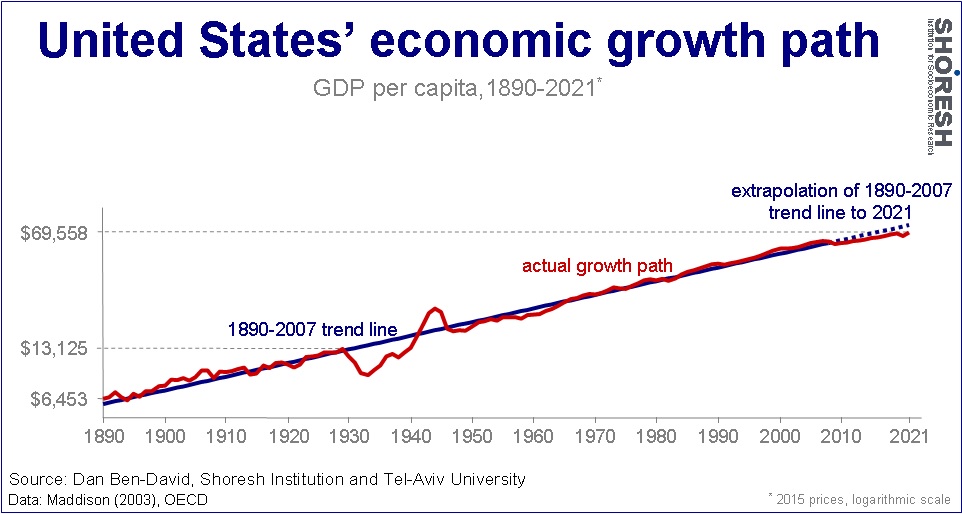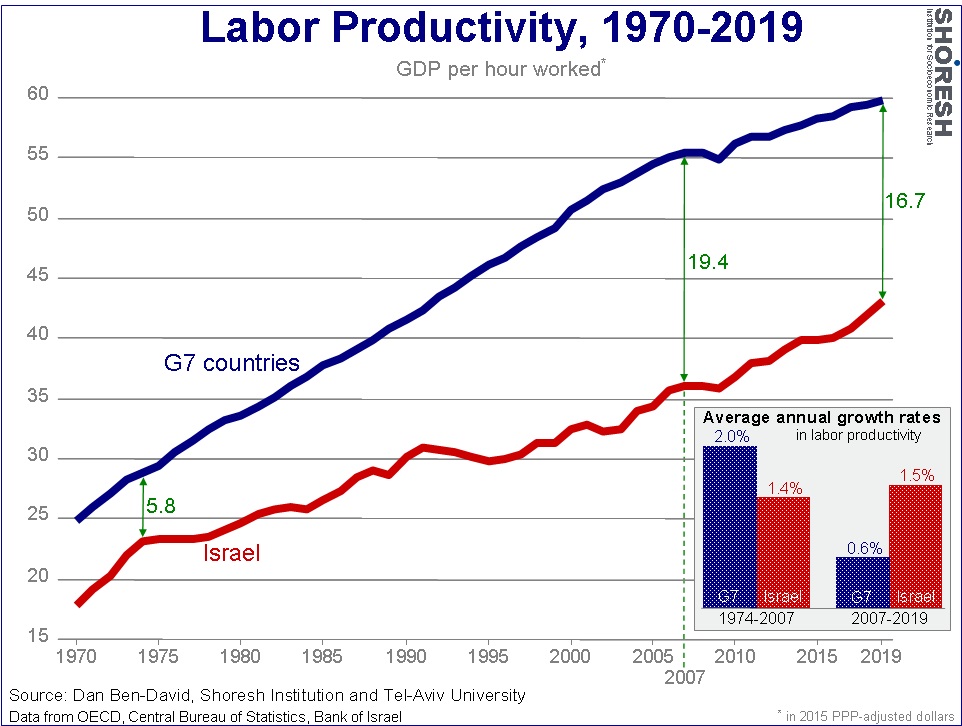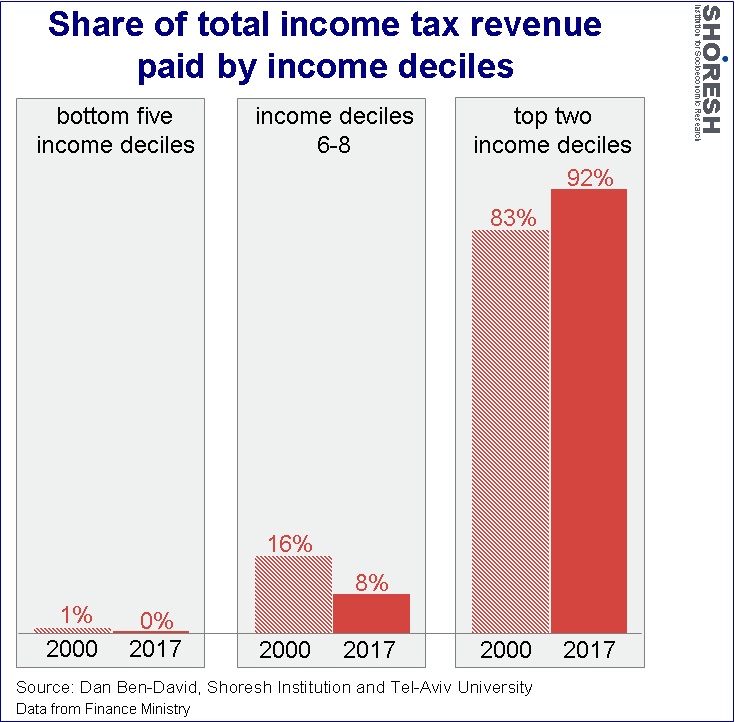|
published
in Times of Israel
on March 9, 2023. Part 1 of 5 The unsustainable path of the start-up nation by Dan Ben-David For years, the economy has been like an engine running on just a few of
its cylinders. The coalition’s judicial overhaul risks exacerbating the strain One of the key broad truths – called "stylized facts" in
economic jargon – of nations’ long-run growth paths is their steadiness. Countries’ living standards (as measured by
their GDP per capita) tend to rise along uncannily steady trajectories. In the case of the United States, living standards grew at a 2 percent
average annual rate between 1890 and 2007, the year before the onset of the
Great Recession. Since that recession, the United States has been below its
long-run path, with the pandemic only further delaying its return to it.

The underlying determinants of a nation’s long-run growth are its key
infrastructures, ranging from physical and human capital (e.g., education) to
its legal and bureaucratic systems. A nation’s priorities determine how much of
its budget is focused on maintaining and improving these key infrastructures.
As these progressively improve over time, productivity rises, bringing up
living standards together with it. Major events may cause a country to fall under the long-run path into a
recession, or to rise above it into inflationary periods. Given the short time horizons of
democratically elected governments, most of their attention tends toward
smoothing out these business cycles and getting reelected. While governments may differ in their approaches
to shortening recessions and reducing inflation, they rarely have the bandwidth
to focus on the bigger questions regarding infrastructures that affect the
height and the slope of the entire path.
Consequently, policy changes in these realms tend to be less significant
and long-lasting – hence, the steadiness of the long-run paths. Israel has been beset by major events at a pace and magnitude
experienced by few – if any – other countries.
Major wars, hyperinflation, and massive waves of immigration increasing
the country’s population by several orders of magnitude, have combined to give
Israelis a sense of skepticism with regard to the applicability of economic
“stylized facts” within the country. And yet, Israel is no exception to this long-run growth rule – while
also a being prime example of how a dramatic shift in national priorities can
lead to a sharp pivot in the long-run path.

The slope of the growth path reflects the rate of economic growth. The steeper the path, the faster the
growth. Israel’s growth path from 1950 (two years after attaining independence)
to the 1973 Yom Kippur war was truly exceptional. Despite a major recession in the early 1950s
in which the country had to ration food in order to feed the waves of destitute
immigrants that inundated it, Israel managed to grow at a phenomenal pace. It not only managed to feed and house the new
immigrants – while having to defend its very existence in wars by neighbors
determined to destroy it – it also found the wherewithal to build the
infrastructures of a modern nation. When
compared to the eight countries with GDP per capita most similar to Israel’s in
the early 1950s (see upper left graph insert), Israel grew faster than most
during its first decades. The massive surprise attacks on Israel on Yom Kippur in 1973 shook the
country to its core. Israel’s Labor
party leadership (in its various formats), which had led Israel since its
birth, was perceived to be smug and overconfident, increasingly corrupt and out
of touch with Israel’s real needs. Huge
and persistent nationwide protests ultimately led to Israel’s first political
upheaval since its birth. In those 1977
elections, Likud took over the leadership mantel and formally cemented changes
in Israel’s national priorities. Some of these changes had already begun a couple of years earlier with
the first illegal West Bank settlements receiving tacit government
approval. These policies were set in
stone and broadened by the new right-wing government. Another vital partner enabling the formation
of the new coalition in 1977 was the haredim (ultra-Orthodox Jews), who had
never before been coalition partners in any government. Instead of recovering from the Yom Kippur War and eventually returning
to its earlier long-run growth path, the changes in national priorities shifted
Israel to a new, much slower path (the extent of this shift is highlighted in
the lower right graph insert). When
compared to the eight countries with GDP per capita most similar to Israel in the
mid-1970s (four countries ranked immediately above and four countries ranked
immediately below Israel), the country’s average annual growth of 1.8% placed
it near the bottom of the group. Despite it being home to the “start-up nation”, the rest of Israel has
been left far behind. A sharper focus
reveals just how problematic the post-seventies trajectory actually is. The average hourly wage in a country cannot
be high if the average amount produced per hour is low. Specifically, hourly wages at the national
level are strongly related to GDP per hour worked – also known as labor
productivity.

Labor productivity in Israel is below that of all the relevant developed
countries. As such, the country’s
average hourly wage is also below all of these countries. A long-term comparison of Israel’s labor productivity with the average
of the G7 countries that lead the developed world (the United States, Canada,
the United Kingdom, Germany, France, Italy and Japan) shows just how
problematic Israel’s growth picture actually is. Between the mid-1970s and 2007, the gap
between the G7 and Israel grew nearly four-fold. Labor productivity growth in the G7 averaged
2% during this period, compared to 1.4% in Israel.

While a small part of Israel’s population propelled its hi-tech sector
to the frontiers of human knowledge, the remainder of the population did not
receive either the tools or the conditions to work in a modern economy. Israel’s schools are the developed world’s
worst (more on this in a later piece in this series) while its physical
infrastructure was neglected. The
outcome is similar to an engine running on just a few of its existing
cylinders. It is extremely difficult for
those few exceptional cylinders to move the entire vehicle forward. Following the onset of the Great Recession in the latter part of 2008,
the G7 countries slipped to a slower growth path, with their average annual
productivity growth falling to just 0.6%.
In light of Israel’s strong dependency on its hi-tech sector, a sector
much less affected by the Great Recession, the country’s labor productivity
growth remained nearly unchanged, at 1.5% per annum. Contrary to public perception, the reduction in the gap between the G7
and Israel was not due to a major upward shift in Israel’s path – which has
been extremely steady since the mid-1970s – but rather to the decline in the
G7’s path. Presumably, the stylized fact
describing long term national growth will eventually reassert itself and the G7
will return to its previous path, while there is nothing on the horizon to
suggest that Israel will shift to a new, faster growth path. As such, the big picture emanating from the graph above is not
sustainable. Though Israel has received
a temporary reprieve in recent years, it cannot continue to fall further and
further behind in the long term. While
there are many Israelis who will remain in the country no matter what, the
greater the gap between the leading developed-world nations and Israel, the
greater the incentive for many to emigrate. Importantly, in a country of nearly 10 million people, there is no need
for 1-2 million to leave for Israel to collapse. The hi-tech sector employs just a tenth of
Israel’s work force, but it is responsible for over half of the country’s exports. The quality of Israel’s healthcare is
ultimately determined by its physicians.
They account for roughly one-half of one percent of the adult (25+)
population. The majority of the
country’s hi-tech leaders and physicians are educated in Israel’s cutting-edge
research universities. The senior
faculty in these institutions comprise just 0.2% of Israel’s adult population.

In short, fewer than 400,000 individuals are responsible for keeping
Israel in the developed world. If a
critical mass of them decide to leave, the consequences for Israel will be
catastrophic. A different perspective of the country’s dependency on the shoulders of
just a few can be gleaned from the distribution of income tax payments, who
shoulders the burden and who does not.
Half of Israel’s adults are so poor that they do not even reach the
bottom rung of the income tax ladder, and they pay no income tax at all. In 2017, 92% of all income tax revenue came
from just 20% of the adults, rising from 83% of all income tax revenue in the
year 2000. Over time, this situation has only been exacerbated, as a large – and growing – population is being left
behind.

With the labor productivity gap growing between the leading countries
and Israel, alongside a growing income tax burden on the country’s most skilled
and educated persons, the emigration process has already begun. The new coalition's judicial overhaul did not initiate the brain drain
from Israel, but it may become a major accelerant to the already problematic
process. An examination of all Israelis
receiving academic degrees between 1980 and 2010 shows that for every such
Israeli who returned to Israel in 2014, another 2.8 left the country. By 2018 (the most recent data), this number climbed
to over 4 emigrants for every returnee.
While the absolute numbers are still small, a continuation of this trend
is unsustainable.

A similar trend reflects what is transpiring among Israel’s
physicians. In 2006, the number of
Israeli physicians practicing in other OECD countries was 9.8% of the total
number practicing in Israel. A decade
later, this number rose by nearly half, to 14% in 2016.

The emigration of Israel’s most skilled and educated citizens has still
not reached a critical mass. But the
increasing gaps between what these individuals could earn elsewhere and what
they earn in Israel has no doubt contributed significantly to the direction,
and the steadiness, of the emigration paths – especially when the other aspects
of life in Israel, and what the future holds, are also factored in. These days, when the new government is running roughshod over the
liberal ideals of a large part of Israel’s educated and skilled workforce, it
would be a good idea to stop the process in its tracks and give a little
thought to the kind of country that in which our children will have to live, or
leave. |